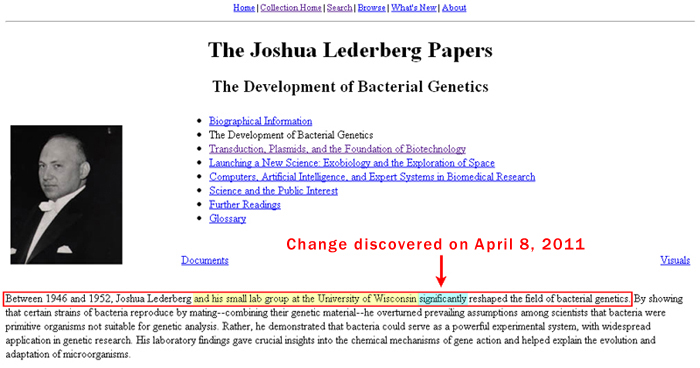
The NLM website makes several further false claims, thereby establishing repeated, systematic distortions of the historical record. Thus this site clearly intends to deceive. It is correctly claimed that Joshua Lederberg discovered "conjugation" in bacteria, and then goes on to falsely conflate conjugation (associated with pilli), with the "Fertility Factor F" (between which the distinction is not even drawn). Once again, no citation is provided. In addition to the false confusion between conjugation and the Fertility Factor F, the NLM site then goes on to further confuse the situation by conflating the Fertility Factor F with the 1952 research by Bill Hayes and his "Sex Factor". Indeed, Esther M. Lederberg's Fertility Factor F doesn't directly take part in E. coli conjugation; rather, it was the first bacterial episome discovered and it becomes active during its prophage stage (lysogenization). There is no question that Joshua Lederberg discovered sexual conjugation in bacteria. The problem is the false claim that sexual conjugation is the same thing as Fertility Factor F. The actual quote, below, was found on the NLM website on April 8, 2011:
"Between 1947 and 1952, Lederberg continued to work on a linkage map [of] the E. coli K12 chromosome, exploiting the fact that in recombination, unrelated genes are functionally linked to show where these genes were located on the chromosome in relative distance to one another. His efforts grew to "rabbinical complexity," as James Watson wrote in The Double Helix (1968), for the very reason that Lederberg continued to adhere to his analogy between bacterial cells and the cells of higher organisms. This analogy suggested that in the process of mating, the two parental bacteria merged their entire genetic resources, as is the case in higher organisms. The complexities in Lederberg's linkage map could not be resolved until the Irish bacteriologist William Hayes reported in 1952 that during conjugation, one partner of the mating pair, the male, acted as a donor, and that the other, the female, acted as recipient. Furthermore, Hayes showed that the male donor transferred only part of its genes to the female recipient; complete genomes were not merged in the same cell. Both results ran counter to Lederberg's assumptions about the nature of the bacterial cell, and both proved essential to understanding the mechanism of sexual recombination in bacteria in molecular detail. More generally, Hayes' discovery created an understanding that with regard to the mating process and many structural and physiological characteristics, bacterial cells are fundamentally different from the cells of higher organisms. Since 1962, these differences have been denoted by the terms prokaryotic and eukaryotic cells."
Evidence to decisively support the false claims and confusions found on the NLM site follow.
In an oral history interview at Stanford University concerning Fertility Factor F, Esther M. Lederberg clearly stated that the her discovery of Fertility Factor F was due to her work with lambda phage. It should be recalled that the lambda phage was also discovered solely by Esther M. Lederberg, as described in detail in her January 1950 paper (E. Witkin, Editor; see the section that discusses bacteriophage lambda). The discovery of lambda phage led directly to the discovery of Fertility Factor F. Esther M. Lederberg explicitly states that she did consult with Josh Lederberg (and the other lab members) about her discovery of Fertility Factor F. Thus Josh Lederberg was indeed one of those consulted, but he did not discover Fertility Factor F. Multiple written versions recounting the history of Fertility Factor F in relation to the work done by Hayes, Jacob, Wollman and Cavalli-Sforza are provided in the links below.

Esther M. Zimmer Lederberg to François Jacob
(Maleness Transferred by Infection at High Frequency, 1/12/1961)
The following section provides access to the documents from which the above excerpts were taken.
To access an honest history of the Fertility Factor F episome, click here